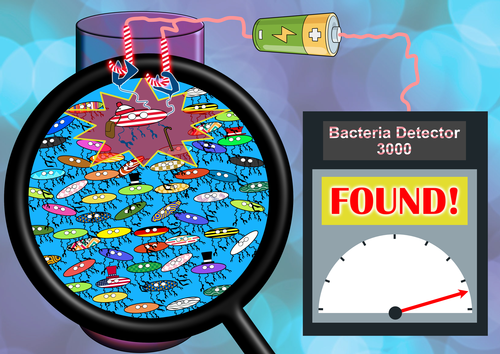FRIDAY, APRIL 12, 2024
A novel sensor developed by researchers at Goethe University Frankfurt and Kiel University in Germany can reportedly detect dangerous bacteria in food production, as well as diagnose diseases.
Based on a chip with an innovative surface coating, the sensor ensures that only specific microorganisms, such as pathogens, adhere to it. The sensor generates a stronger electric signal as it collects a larger number of organisms, allowing users to both detect bacteria and its concentrations.
About the Study
According to the scientists, traditional methods to detect harmful microorganisms are often time-consuming, require expensive equipment or can only be used by specialists. They are also unable to distinguish between active bacteria and their decay products.
The newly developed method, on the other hand, detects only intact bacteria. It reportedly utilizes the fact that microorganisms only ever attack certain body cells, which they recognize from the latter’s specific sugar molecule structure.
The matrix, or glycocalyx, differs depending on the type of cell, serving as an identifier for the body cells. This means that to capture a specific bacterium, the recognizable structure in the glycocalyx of its preferred host cell must be known and then can be used as “bait.”

 |
| Goethe University Frankfurt |
|
A novel sensor developed by researchers at Goethe University Frankfurt and Kiel University in Germany can reportedly detect dangerous bacteria in food production, as well as diagnose diseases. |
“In our study, we wanted to detect a specific strain of the gut bacterium Escherichia coli—or E. coli for short,” explained professor Andreas Terfort from the Institute of Inorganic and Analytical Chemistry at Goethe University Frankfurt.
“We knew which cells the pathogen usually infects. We used this to coat our chip with an artificial glycocalyx that mimics the surface of these host cells. In this way, only bacteria from the targeted E. coli strain adhere to the sensor.”
E. coli has many short arms, known as pili, which the bacterium uses to recognize its host's glycocalyx and cling onto it.
“The bacteria use their pili to bind to the sensor in several places, which allows them to hang on particularly well,” said Terfort.
Additionally, the chemical structure of the artificial glycocalyx is such that microbes without the right pili slide off it, similar to an egg sliding off a well-greased frying pan. This ensures that indeed only the pathogenic E. coli bacteria are retained.
During the research, the scientists were reportedly able to corroborate that bacteria was attached to the artificial glycocalyx.
“We bonded the sugar molecules to a conductive polymer,” explained Sebastian Balser, a doctoral researcher under Terfort and the first author of the paper. “By applying an electrical voltage via these ‘wires,’ we are able to read how many bacteria had bonded to the sensor.”
The researchers reportedly mixed pathogens from the targeted E. coli strain among harmless E. coli bacteria in various concentrations.
“Our sensor was able to detect the harmful microorganisms even in very small quantities,” explained Terfort. “What's more, the higher the concentration of the targeted bacteria, the stronger the emitted signals.”
Since the research is initial proof that the method works, in the next phase, the team wants to investigate whether it also stands the test in practice. For example, the researchers want to look at whether using it in regions where there are no hospitals with sophisticated lab diagnostics is conceivable.
Tagged categories: Antibacterial coatings; Coating chemistry; Coating Materials; Coating Materials; Coating Materials - Commercial; Coatings; Coatings technology; Coatings Technology; Colleges and Universities; Food Processing Plants; Good Technical Practice; Health & Safety; Health and safety; Health Care/Hospitals; Research and development